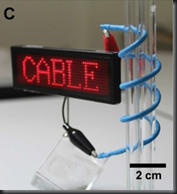
 Modern day batteries, such as the ones that power your laptop or mobile device, consist of layers of materials. Typically there are anode, a cathode, and an electrolyte layers that are laminated together into a brick-like battery. LG has broken out of the box and developed a rope-like battery that is manufactured using twisted layers. This cable-type lithium-ion battery is just a few millimeters thick and flexible enough to be tied in knots, strung along a casing, or woven into clothing.
Modern day batteries, such as the ones that power your laptop or mobile device, consist of layers of materials. Typically there are anode, a cathode, and an electrolyte layers that are laminated together into a brick-like battery. LG has broken out of the box and developed a rope-like battery that is manufactured using twisted layers. This cable-type lithium-ion battery is just a few millimeters thick and flexible enough to be tied in knots, strung along a casing, or woven into clothing.
LG Chem’s battery starts with thin strands of copper wire, which are coated with a nickel-tin (Ni-Sn) alloy to create the anode. These strands are twisted into a yarn, and then wrapped tightly around a 1.5mm-diameter rod. The rod is removed, leaving a strong spring. Next, aluminum wire is wrapped around the spring, and then the whole caboodle is dragged through a slurry of lithium cobalt oxide, which coats the aluminum wire and becomes the cathode. Finally, the anode-cathode spring is wrapped in a protective outer coating, and then an electrolyte is poured down the middle of the hollow spring to create a battery.
This opens up a world of opportunities for device manufacturers who to date, have been limited to rectangular shaped batteries. Such a block-like design limits the internal layout of their product and forces the squared design we see in pretty much all electronic devices. Using a rope-like battery, manufacturers will be able to cram battery material into empty spaces or even include as decorative windings around the outside of the case.








